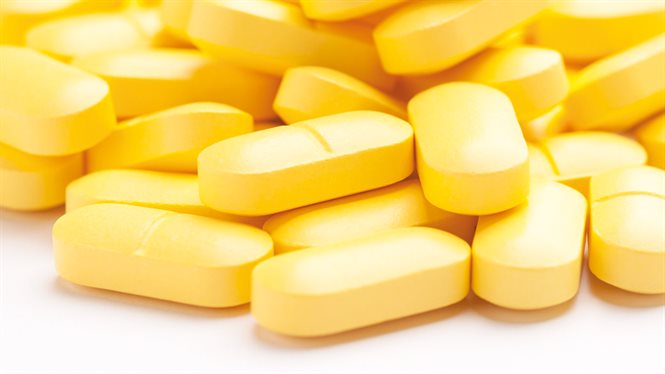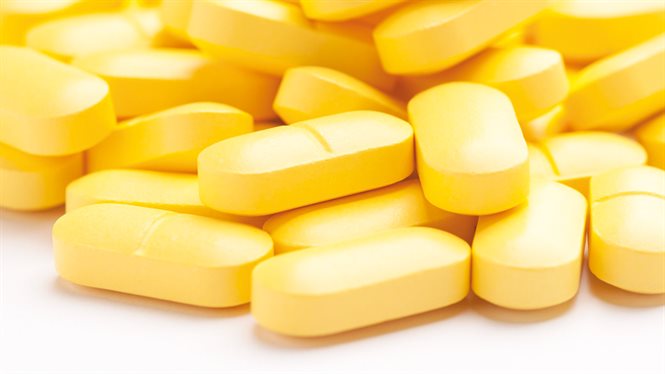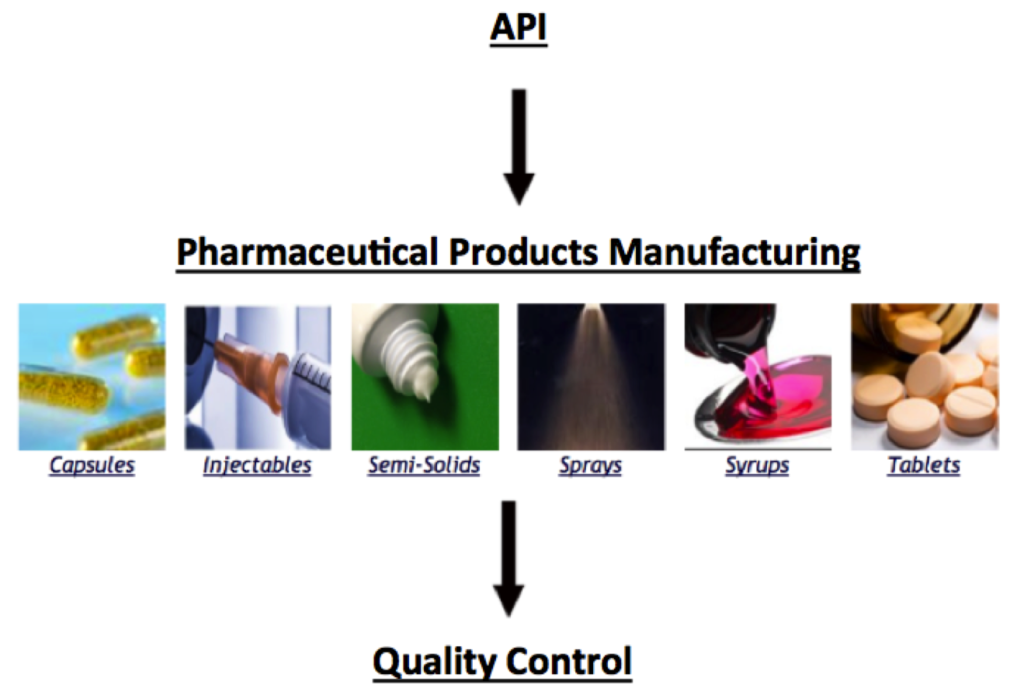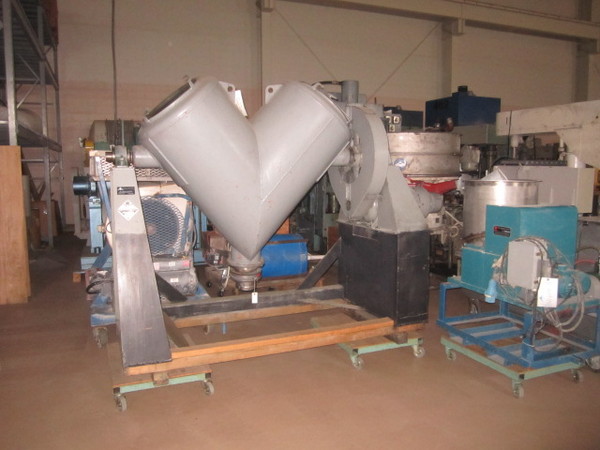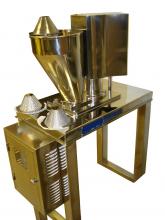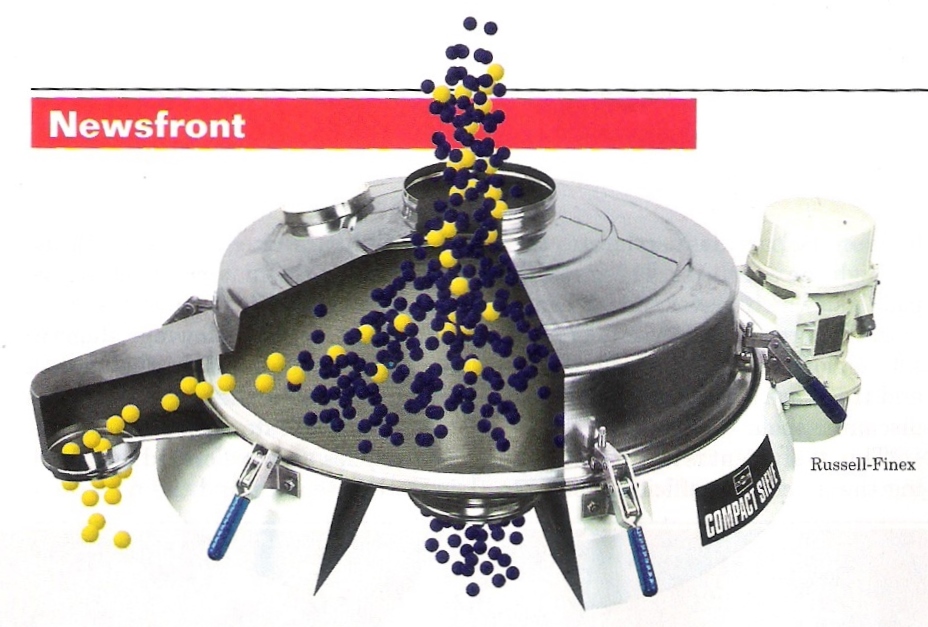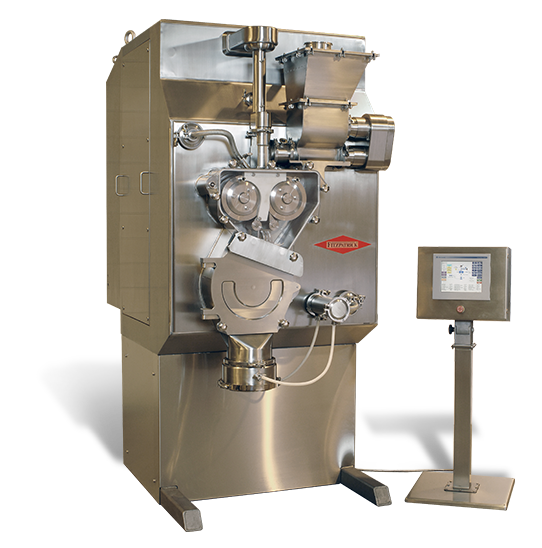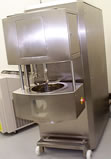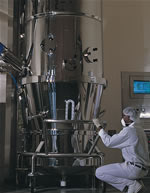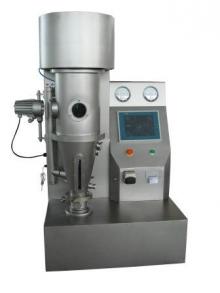Tablets are pharmaceutical products made from compressed solids. Tablets are delivered to the body through ingestion. In pharmaceutical tablet production, the API is granulated into fine particles that are compressed into the basic tablet structure. Lastly, a coating is applied to the tablet to hold the particles together.
This module describes equipment used in the tablet manufacturing process. The Quality Control module describes additional equipment used to monitor quality parameters during this process.
Pharmaceuticals Process Map
Granulation
During granulation, API is blended with binders, fillers, coloring materials, and lubricants. This operation increases the density and uniformity of the mixture for the next step, compression. Three types of granulation are used in tablet manufacturing, dry, wet, and spray granulation, depending on the properties of the drug being produced. The following sections describe the equipment used in these three granulation techniques.
V-Blender
The v-blender can be used in all types of granulation processes to mix lubricants and powdered API. These blenders are made of two cylinders attached at an angle and mounted to an external frame. As the blender begins to tumble the material randomly mixes, which causes the final blend to be homogeneous. For this reason, these blenders are preferred in the pharmaceutical industry to ensure tablet uniformity.
Cone Mill
Cone mills are the most widely used granulation equipment in tablet production because they can perform both dry and wet milling, depending on the type of granulation required. Material is fed from a previous machine by gravity into the mill. As the material enters the conical chamber, it is forced to the wall by the spinning rotor. The rotor blades exert shear stress on the material, which causes a reduction in granule size. Once the granules are small enough, they pass through the holes on the walls of the conical chamber and fall into a container.
Sieve
A sieve is a type of centrifugal screener used in all types of granulation processes to remove large particles from the API mixture that could cause problems in subsequent processes. Most pharmaceutical sieves have circular housings with an attached steel mesh, with opening sizes depending on the needs of the process. The housing is then vibrated to allow particles to pass through the mesh to the next part of the process.
Roller Compactor
The roller compactor is only used in dry granulation to compact the lubricated powder to produce granules. The material is fed through a chute into two compacting wheels that compress the material into thin flakes. The material then exits into a dry cone mill to produce granules.
Mixer Granulator
A mixer granulator is used in wet granulation to combine the powder mixing, wetting, wet massing, and cutting operations of the granulation process. In powder mixing, an impeller and chopper first rotate at high speeds to break up any clumps in the API powder, then a liquid solution that binds the powder is charged to the system. The impeller and chopper are then switched to a low speed to evenly mix the solution into the powder, after which it is switched back to high speed to increase the size of the granules. The material is then discharged to the next step in the process. Mixer granulators may be equipped with a heating or cooling jacket to operate at the desired temperature. The main bowl of the machine may also be on a pivot for more effective heat exchange.
Fluid Bed Dryer
A fluid bed dryer is used in the wet granulation process to dry the material that is fed from a mixer granulator or wet cone mill. Similar to the API drying process, the air is filtered and circulated through the bed of material.
Spray Dryer
A spray dryer is used in the spray granulation process, which is only used when the materials are all soluble in a common solvent. Inside the dryer, a gas is fed co-currently or countercurrent over the feed stream, evaporating the solvent. The solids are then separated from the gas stream by filters. The resulting particles are uniform and can be fed to the next process.
Compression
The next step of tablet production is compression. During this step, the granules are compressed into the basic structure of the final tablet product.
Tablet Presses
Tablet presses hold the feed granules in a die, which is called a station. Then granules are compressed by two punches of the same size. Two types of tablet presses include eccentric presses, with a single station, and rotary presses, with several stations. These stations can vary in diameter and compression forces to produce a wide range of tablet shapes and sizes. They can also produce tablets that are chewable, multi-layered, have delayed-release, and other special designs.
Coating
The final step in tablet production is coating. Tablets need to be coated because the API may have an unpleasant taste or a controlled release rate of API is needed. Common equipment used to coat compressed tablets includes horizontal pan coaters and fluidized bed coaters.
Horizontal Pan Coater
A horizontal pan coater consists of a rotating drum and a spraying system. Tablets are charged to the system from an intermediate bulk container and are sprayed with the coating solution while they tumble. This ensures that each tablet is completely covered with the solution. At the same time warm, filtered air is blown across the tablets to help dry the coating. This process is normally repeated five times to seal, dry, sub-coat, color coat, and polish the tablets, creating a smooth finish.
Fluidized Bed Coater
In a fluidized bed coater, the tablets are loaded to the bottom of the tablet bed. The coating solution is sprayed from the bottom of the tablet bed while filtered air is also blown through from the same location. This creates a circulation of spray, air, and tablets that results in an even application of the solution. This process is also aided by a spinning platform on which the tablet bedsits, resulting in a smooth finish.
After coating, the tablets are ready for testing against the product specifications. The Quality Control module describes equipment relevant to this testing process.
Acknowledgements
- Aadvanced Machinery Inc., Clinton Township, MI
- Chemical Engineering, Access Intelligence, LLC
- Fitzpatrick , Elmhurst, IL
- GEA Process Engineering Inc., Columbia, MD
- Mendel Company, East Hanover, NJ
References
- Bennett, Bill, and Cole, Graham. Pharmaceutical Production: An Engineering Guide. United Kingdom: The Institution of Chemical Engineers, 2002. Print.
- Cone Mills. Bristol, PA: Kemutec. Web. kemutecusa.com.
- Ende, David J. Chemical Engineering In the Pharmaceutical Industry: R&D to Manufacturing. Hoboken: Wiley, 2010.
- O’Connell, Rob. “Sieve Use in the Pharmaceutical Industry.” PharmTech. UBM Advanstar, 1 May 2005. Web.www.pharmtech.com
- Roller Compactors for Dry Granulation. Germany: Powtec, n.d. Powtec. Powtec. Web. www.powtec.de.
- Tekchandaney, Jayesh. “V-Blenders.” Bright Hub Engineering. Bright Hub, Inc., 23 Oct. 2009. Web. www.brighthubengineering.com.
- Wang, H.Y, University of Michigan, personal communications, 2015.
Developers
- Thomas Plegue
- Howard Hsu
- Nathan Hoffman
- James Rivard

